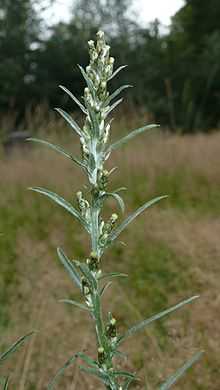Gnaphalium sylvaticum
From Wikipedia, the free encyclopedia
| Gnaphalium sylvaticum | |
|---|---|
 | |
| Scientific classification | |
| Kingdom: | Plantae |
| (unranked): | Angiosperms |
| (unranked): | Eudicots |
| (unranked): | Asterids |
| Order: | Asterales |
| Family: | Asteraceae |
| Tribe: | Gnaphalieae |
| Genus: | Gnaphalium |
| Species: | G. sylvaticum |
| Binomial name | |
| Gnaphalium sylvaticum L. | |
Gnaphalium sylvaticum, commonly known as wood cudweed and heath cudweed, is a weedy plant found in the North Temperate Zone. It was first formally described by Carl Linnaeus in 1753.[1]
Description
It is a perennial herb with short runners.
The plant is 8 to 60 cm tall.
The leaves are lanceolate in shape, pointed, 2 to 8 cm long, with a single vein. They have no hair on top, but are whooly hairy below. The upper leaves become progressively shorter and narrower.
The flower heads are 6mm long. The bracts of the flower heads have a green centre, and chaffy brown edges. The florets are pale brown. The achenes are hairy with reddish pappus hairs.
If flowers from July until September.
References
| Wikimedia Commons has media related to Gnaphalium sylvaticum. |
- ↑ International Organization for Plant Information (IOPI). "Plant Name Search Results" (HTML). International Plant Names Index. Retrieved 18 March 2009.
- ↑ Rose, Francis (1981). The Wild Flower Key. Frederick Warne & Co. pp. 377–380. ISBN 0-7232-2419-6.
This article is issued from Wikipedia. The text is available under the Creative Commons Attribution/Share Alike; additional terms may apply for the media files.